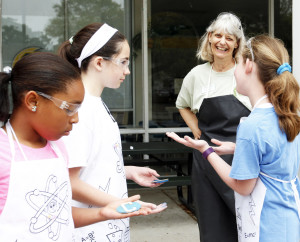Ann Smart, Science Department Head, led the campers on an adventure exploring the mysteries of solar power and plants during the Saturday morning camp. The campers started by threading UV light sensitive bead on ribbons to create necklaces. When exposed to UV light, the beads react by transforming from white to the colors of the spectrum, producing unique, rainbow colored necklaces. Campers also experimented with Sunprint paper, leaf prints, and flowers. Sunprints are filter paper dipped into chemicals to make the paper UV sensitive. Using stencils, the students exposed the paper to sunlight to form a blue and white print of the stencil.
During the plant section of the camp, the students created leaf prints by placing a leaf under a sheet of paper and gently rubbing the paper with colored pencil or crayon to show the leaf details. Campers also learned about plant reproduction by dissecting azaleas to identify the flowers’ petals, sepals, pistil, and stamen. For home study, the campers made “sock animals” by drawing faces on white socks, filling the socks with quick-growing grass seed and potting soil, and soaking the sock animals in water. In a few days, the sock animals will grow grass “hair,” allowing the campers to witness seed germination and plant growth.

Cabrini Super Science Saturday
3.19.16
Photo: Tyler Kaufman/©2016
“Best practices indicates that students grasp science and math concepts more readily when combined with practical application, so we incorporate theory and utility in all our STEM courses and activities, including our camps,” stated Smart. “The UV beads and sunprints allow the girls to grasp the existence and significance of UV light energy. When we introduce plant reproduction combined with the sunprints and the sock animals, the campers are able to witness how nature converts light, seeds, soil, and water into living, growing plants. It is an eye-opening moment for many youngsters as they realize for the first time all of the invisible and mysterious scientific processes occurring around them each and every day.”
